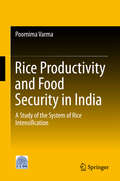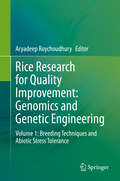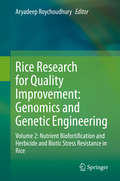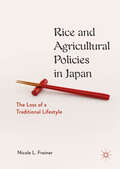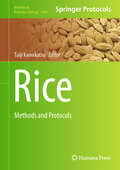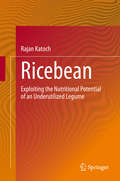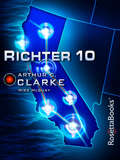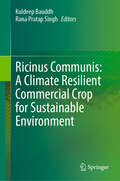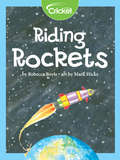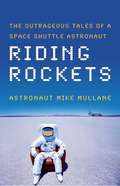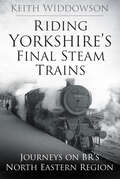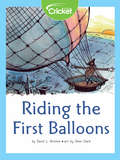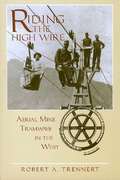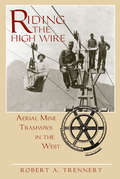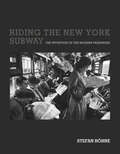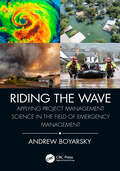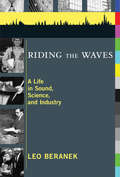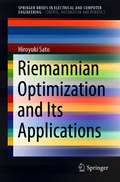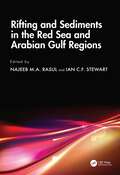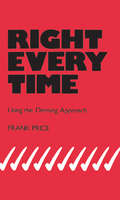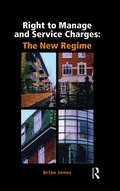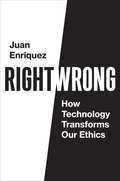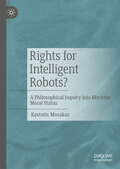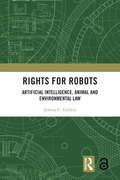- Table View
- List View
Rice Productivity and Food Security in India
by Poornima VarmaThis book contributes to the adoption of agricultural technology in general and to literature on the System of Rice Intensification (SRI) in particular by identifying the factors that influence the decision to adopt SRI and examining SRI's impact on household income and yield. The study also discusses the importance of SRI in achieving higher rice productivity and food security. Conducted on behalf of the Government of India's Ministry of Agriculture from October 2014 to March 2016, the study collected detailed and extensive household-level data. As the second largest producer and consumer, India plays an important role in the global rice economy. Food security in India has been traditionally defined as having a sufficient supply of rice at an affordable price. However, in recent years rice cultivation in India has suffered from several interrelated problems. Increased yields achieved during the green revolution period and with the help of input-intensive methods involving high water and fertiliser use are now showing signs of stagnation and concomitant environmental problems due to salinisation and waterlogging of fields. Water resources are also limited; as such, water for irrigation must contend with increasing industrial and urban needs. As a result of all these factors, rice farmers have experienced a downturn in productivity growth. Since increasing the area of rice cultivation is not feasible, the additional production has to be achieved using less land, less water and fewer additional inputs. The new intensification methods for rice cultivation known as the System of Rice Intensification (SRI), which originated in Madagascar, offer a promising systemic approach to enhancing rice production at affordable costs by simultaneously reducing input requirements and causing less harm to the environment. The SRI approach is expected to enhance yield and substantially reduce water and other input requirements by altering plant, soil, water and nutrient management practices. With SRI taking firm root in India, the book examines and analyses the adoption and the economic impact of SRI in three major rice producing States of India: Karnataka, Madhya Pradesh and Orissa.
Rice Research for Quality Improvement: Volume 1: Breeding Techniques and Abiotic Stress Tolerance
by Aryadeep RoychoudhuryThis book focuses on the conventional breeding approach, and on the latest high-throughput genomics tools and genetic engineering / biotechnological interventions used to improve rice quality. It is the first book to exclusively focus on rice as a major food crop and the application of genomics and genetic engineering approaches to achieve enhanced rice quality in terms of tolerance to various abiotic stresses, resistance to biotic stresses, herbicide resistance, nutritional value, photosynthetic performance, nitrogen use efficiency, and grain yield. The range of topics is quite broad and exhaustive, making the book an essential reference guide for researchers and scientists around the globe who are working in the field of rice genomics and biotechnology. In addition, it provides a road map for rice quality improvement that plant breeders and agriculturists can actively consult to achieve better crop production.
Rice Research for Quality Improvement: Volume 2: Nutrient Biofortification and Herbicide and Biotic Stress Resistance in Rice
by Aryadeep RoychoudhuryThis book focuses on the conventional breeding approach, and on the latest high-throughput genomics tools and genetic engineering / biotechnological interventions used to improve rice quality. It is the first book to exclusively focus on rice as a major food crop and the application of genomics and genetic engineering approaches to achieve enhanced rice quality in terms of tolerance to various abiotic stresses, resistance to biotic stresses, herbicide resistance, nutritional value, photosynthetic performance, nitrogen use efficiency, and grain yield. The range of topics is quite broad and exhaustive, making the book an essential reference guide for researchers and scientists around the globe who are working in the field of rice genomics and biotechnology. In addition, it provides a road map for rice quality improvement that plant breeders and agriculturists can actively consult to achieve better crop production.
Rice and Agricultural Policies in Japan: The Loss Of A Traditional Lifestyle
by Nicole L. FreinerThis book chronicles Japan’s rice farmers who live in mainly rural areas in the west and south of Japan through original interviews conducted in Japanese. It argues that current agricultural policy as well as the tightening relationship between the US and Japan is a death sentence for a traditional lifestyle that is vital to Japan’s notion of national identity. The project covers recent agricultural policies, including the Trans-Pacific Partnership (TPP) agreement and its potential consequences on Japan’s food sovereignty and documents the effect of these policies on rice farmers. This volume is ideal for those interested in Japan’s agricultural policies and rural and traditional Japanese lifestyle.
Rice: Methods and Protocols (Methods in Molecular Biology #2869)
by Taiji KawakatsuThis volume aims to be a comprehensive guide to the field of rice molecular biology, encompassing both time-honored techniques and state-of-the-art methodologies. Chapters detail sample preparation, temporal and spatial analysis of RNA, protein expression, transformation and precise genome editing, scalable transcriptome analysis, epigenome analysis, and gene regulatory network analysis. Written in the highly successful Methods in Molecular Biology series format, chapters include introductions to their respective topics, lists of the necessary materials and reagents, step-by-step, readily reproducible laboratory protocols, and key tips on troubleshooting and avoiding known pitfalls. Authoritative and cutting-edge, Rice: Methods and Protocols aims to ensure successful results in the further study of this vital field.
Ricebean: Exploiting the Nutritional Potential of an Underutilized Legume
by Rajan KatochThis book presents valuable research and advances in technologies related to ricebean cultivation production and utilization. Focusing on ricebean as a possible solution to the problems of nutritional insecurity and growing populations in developing countries, it provides comprehensive insights into its nutritional significance as an alternative food legume and discusses its utilization to prevent potential food calamities. This book is a valuable resource for food scientists and technologists, agricultural scientists, nutritionists and researchers.
Richter 10 (Arthur C. Clarke Collection)
by Arthur C. Clarke Mike McQuayPolitical and environmental disasters come crashing down in this earthquake sci-fi thriller co-written by the authors of 2001: A Space Odyssey and Memories. When he was seven years old, Lewis Crane survived the Los Angeles earthquake of 1994—but his parents did not. Haunted by the tragedy, Crane has dedicated his life to protecting humanity from similar disasters. Now he is a Nobel Prize–winning earthquake scientist who perfected equipment sensitive enough to predict an earthquake strike down to the minute. And he wants to go further. Crane has formed an organization to explore the idea of stopping earthquakes entirely by fusing the Earth&’s tectonic plates together. But what effect will this have on the earth? And as political unrest causes tremors of another kind, can Crane&’s audacious plan stop another major earthquake due to hit the United States? Co-written by Hugo and Nebula Award–winning author Arthur C. Clarke and Philip K. Dick Award–winning author Mike McQuay, the &“two formidable SF talents converge splendidly in this disaster thriller, which offers sleek action-adventure writing, world-class tumult and a coherent near-future based on sound yet innovative social and scientific speculation&” (Publishers Weekly).
Ricinus Communis: A Climate Resilient Commercial Crop for Sustainable Environment
by Rana Pratap Singh Kuldeep BauddhDue to the diverse properties of Ricinus communis (castor), this book provides a comprehensive account of castor as a ‘climate resilient and value-added crop.’ It explores the morphological variations, various cultivation techniques, genotypic differences, suitable soil types, and the crop’s yield. The book also discusses the phytoremediation efficiency of castor, focusing on its role in restoring degraded lands, abandoned mining sites, and lands contaminated by heavy metals. The application of suitable plants for the restoration of degraded lands is an efficient method due to its ecological and economic viability. Castor is a hardy angiosperm with multiple benefits. It serves the dual purpose of being an excellent phytoremediator and a source of bioenergy. Additionally, castor has proven effective in treating several human diseases. The castor plant's ability to thrive in stressed soils makes it particularly suitable for the phytoremediation of polluted lands in various climatic conditions. Given its wide range of industrial uses, castor has gained significant attention for further exploration of its biology, cultivation techniques, and genotypic variations. This book is of interest to teachers, researchers, botanists, capacity builders, and policymakers. It also serves as good reading material for undergraduate and master students of botany, ecology, and environmental sciences. National and international agricultural scientists, ecologists, and policymakers will also find it a valuable resource
Ride It! Patch It!: An Acorn Book (Racing Ace)
by Larry Dane BrimnerAce enters a mountain bike race in this fast-paced, STEM-themed early reader!Pick a book. Grow a Reader!This series is part of Scholastic's early reader line, Acorn, aimed at children who are learning to read. With easy-to-read text, a short-story format, plenty of humor, and full-color artwork on every page, these books will boost reading confidence and fluency. Acorn books plant a love of reading and help readers grow!Ace polishes up her mountain bike and prepares for the big bike race! She oils the chain and tests the brakes. Then the race begins! But Ace's bike chain comes off the sprocket and then she needs to patch a tire! Will she be able to fix her bike in time and find her way to the finish line?With Larry Dane Brimner's simple text and Kaylani Juanita's full-color artwork on every page, this fast-paced, action-packed book is perfect for new readers!
Riding Rockets
by Rebecca BoyleWhat does it take to fuel a rocket to space? Rocket scientists use hydrogen and liquid oxygen, but could anti-matter engines and black-hole drives fuel our spacecraft of the future?
Riding Rockets: The Outrageous Tales of a Space Shuttle Astronaut
by Mike MullaneOn February 1, 1978, the first group of space shuttle astronauts, twenty-nine men and six women, were introduced to the world. Among them would be history makers, including the first American woman and the first African American in space. This assembly of astronauts would carry NASA through the most tumultuous years of the space shuttle program. Four would die on Challenger. USAF Colonel Mike Mullane was a member of this astronaut class, and Riding Rockets is his story -- told with a candor never before seen in an astronaut's memoir. Mullane strips the heroic veneer from the astronaut corps and paints them as they are -- human. His tales of arrested development among military flyboys working with feminist pioneers and post-doc scientists are sometimes bawdy, often hilarious, and always entertaining. Mullane vividly portrays every aspect of the astronaut experience -- from telling a female technician which urine-collection condom size is a fit; to walking along a Florida beach in a last, tearful goodbye with a spouse; to a wild, intoxicating, terrifying ride into space; to hearing "Taps" played over a friend's grave. Mullane is brutally honest in his criticism of a NASA leadership whose bungling would precipitate the Challenger disaster. Riding Rockets is a story of life in all its fateful uncertainty, of the impact of a family tragedy on a nine-year-old boy, of the revelatory effect of a machine called Sputnik, and of the life-steering powers of lust, love, and marriage. It is a story of the human experience that will resonate long after the call of "Wheel stop."
Riding Yorkshire's Final Steam Trains: Journeys on BR'S North Eastern Region
by Keith WiddowsonKeith Widdowson visited the North Eastern Region of British Railways on over forty occasions during the final eighteen months of steam powered passenger services. With the odd exceptions (usually for railtours) most of the locomotives were neglected, run down, filthy, prone to failure and often only kept their wheels turning courtesy of the skills of the crew coaxing them along with loving care. Far from the scenic delights so often justifiably portrayed of the Yorkshire countryside, the ever-dwindling numbers became corralled within the industrialized heartland of Bradford, Leeds, Wakefield and Normanton. Here, Widdowson recalls that bygone era, leading an almost nomadic nocturnal existence on his self-imposed “mission” of stalking the endangered “Iron Horses” in one of their final habitats. He was often far from alone in his quest. The “Haulage-bashing” fraternity comprised of like-minded enthusiasts from throughout Britain, often congregated, lemming like, on the one-coach early morning mail trains, the Summer Saturday holidaymaker trains or the Bradford portions; indeed any passenger service with a steam locomotive at its front From the many disappointments of thwarted possibilities to the euphoric joy of unexpected catches, together with over 130 contemporary images, Riding Yorkshire's Final Steam Trains is a compelling snapshot of the race against time at the end of the golden age of steam.
Riding the First Balloons
by David L. BristowJoseph Montgolfier and his brother Étienne developed the first balloon. But its first riders were a sheep, a rooster, and a duck!
Riding the High Wire
by Robert A. TrennertRiding the High Wire is the first comprehensive history of aerial mine tramways in the American West, describing their place in the evolution of mining after 1870. Robert A. Trennert shows how the mid-nineteenth century development of wire rope manufacturing made it possible for American entrepreneurs such as Andrew S. Hallidie and Charles Huson to begin erecting single-rope tramways in the 1870s and 1880s. Their inventions were followed by the more substantial double-rope systems imported from Europe. By the turn of the century, aerial tramways were common throughout western mining regions, hauling everything from gold and silver ore to coal and salt and changing the face of the industry. Aerial mine tramways proved to have a special fascination; people often rode them for a thrill, sometimes with disastrous results. They were also very temperamental, needed constant attention, and were prone to accidents. The years between 1900 and 1920 saw the operation of some of the west's most spectacular tramways, but the decline in high-country mining beginning in the 1920s--coupled with the development of more efficient means of transportation--made this technology all but obsolete by the end of the Second World War. Historians and the general reader will be equally enthralled by Trennert's fascinating story of the rise and fall of aerial mine tramways.
Riding the High Wire: Aerial Mine Tramways in the West
by Robert A. TrennertRiding the High Wire is the first comprehensive history of aerial mine tramways in the American West, describing their place in the evolution of mining after 1870. Robert A. Trennert shows how the mid-nineteenth century development of wire rope manufacturing made it possible for American entrepreneurs such as Andrew S. Hallidie and Charles Huson to begin erecting single-rope tramways in the 1870s and 1880s. Their inventions were followed by the more substantial double-rope systems imported from Europe. By the turn of the century, aerial tramways were common throughout western mining regions, hauling everything from gold and silver ore to coal and salt and changing the face of the industry. Aerial mine tramways proved to have a special fascination; people often rode them for a thrill, sometimes with disastrous results. They were also very temperamental, needed constant attention, and were prone to accidents. The years between 1900 and 1920 saw the operation of some of the west's most spectacular tramways, but the decline in high-country mining beginning in the 1920s--coupled with the development of more efficient means of transportation--made this technology all but obsolete by the end of the Second World War. Historians and the general reader will be equally enthralled by Trennert's fascinating story of the rise and fall of aerial mine tramways. "Professor Trennert has explored a new area of mining history, and is to be commended for his pioneering work." --Liston Leyendecker, author of The Griffith Family and the Founding of Georgetown.
Riding the New York Subway: The Invention of the Modern Passenger (Infrastructures)
by Stefan HohneA history of New York subway passengers as they navigated the system's constraints while striving for individuality, or at least a smooth ride.When the subway first opened with much fanfare on October 27, 1904, New York became a city of underground passengers almost overnight. In this book, Stefan Höhne examines how the experiences of subway passengers in New York City were intertwined with cultural changes in urban mass society throughout the twentieth century. Höhne argues that underground transportation--which early passengers found both exhilarating and distressing--changed perceptions, interactions, and the organization of everyday life.
Riding the Wave: Applying Project Management Science in the Field of Emergency Management (ISSN)
by Andrew BoyarskyEmergency managers and public safety professionals are more frequently being called on to address increasingly challenging and complex critical incidents, with a wider variety and intensity of hazards, threats, and community vulnerabilities. Much of the work that falls into the scope of emergency managers – prevention, preparedness, mitigation – is “blue sky planning” and can be contained and effectively managed within projects. This book provides a foundational project management methodology relevant to emergency management practice, and explains and demonstrates how project management can be applied in the context of emergency and public safety organizations.Special features include: an initial focus on risk assessment and identification of mitigation and response planning measures; a clear set of better practices, using a diverse set of examples relevant to today’s emergency environment, from projects to develop emergency response exercises to application development to hazard mitigation; a framework for managing projects at a strategic level and how to incorporate this into an organization’s program, and presents how to develop and manage an emergency program and project portfolio; and suitability as both a hands-on training guide for emergency management programs and a textbook for academic emergency management programs. This book is intended for emergency managers and public safety professionals who are responsible for developing emergency programs and plans, including training courses, job aids, computer applications and new technology, developing exercises, and for implementing these plans and components in response to an emergency event. This audience includes managers in emergency and first response functions such as fire protection, law enforcement and public safety, emergency medical services, public health and healthcare, sanitation, public works, business continuity managers, crisis managers, and all managers in emergency support functions as described by FEMA. This would include those who have responsibility for emergency management functions, even without the related title.
Riding the Waves: A Life in Sound, Science, and Industry (The\mit Press Ser.)
by Leo BeranekThe life and work of Renaissance man Leo Beranek: scientist, professor, engineer, busisess leader, inventor, entrepreneur, musician, television executive, philanthropist, and author.Leo Beranek, an Iowa farm boy who became a Renaissance man—scientist, inventor, entrepreneur, musician, television executive, philanthropist, and author—has lived life in constant motion. His seventy-year career, through the most tumultuous and transformative years of the last century, has always been propelled by the sheer exhilaration of trying something new. In Riding The Waves, Leo Beranek tells his story. Beranek's life changed direction on a summer day in 1935 when he stopped to help a motorist with a flat tire. The driver just happened to be a former Harvard professor of engineering, who guided the young Beranek toward a full scholarship at Harvard's graduate school of engineering. Beranek went on to be one of the world's leading experts on acoustics. He became Director of Harvard's Electro-Acoustic Laboratory, where he invented the Hush-A-Phone—a telephone accessory that began the chain of regulatory challenges and lawsuits that led ultimately to the breakup of the Bell Telephone monopoly in the 1980s. Beranek moved to MIT to be a professor and Technical Director of its Acoustics Laboratory, then left academia to found the acoustical consulting firm Bolt, Beranek and Newman. Known for his work in noise control and concert acoustics, Beranek devised the world's largest muffler to quiet jet noise and served as acoustical consultant for concert halls around the world (including the Tanglewood Music Shed, the storied summer home of the Boston Symphony Orchestra). As president of BBN, he assembled the software group that invented both the ARPANET, the forerunner of the Internet, and e-mail. In the 1970s, Beranek risked his life savings to secure the license to operate a television station; he turned Channel 5 in Boston into one of the country's best, then sold it to Metromedia in 1982 for the highest price ever paid up to that time for a broadcast station. “One central lesson I've learned is the value of risk-taking and of moving on when risks turn into busts or odds look better elsewhere,” Beranek writes. Riding The Waves is a testament to the boldness, diligence, and intelligence behind Beranek's lifetime of extraordinary achievement. Leo Beranek is a pioneer in acoustical research, known for his work in noise control and the acoustics of concert halls, and the author of twelve books on these topics. The many awards he has received include the Presidential National Medal of Science, presented in 2003.
Riemannian Optimization and Its Applications (SpringerBriefs in Electrical and Computer Engineering)
by Hiroyuki SatoThis brief describes the basics of Riemannian optimization—optimization on Riemannian manifolds—introduces algorithms for Riemannian optimization problems, discusses the theoretical properties of these algorithms, and suggests possible applications of Riemannian optimization to problems in other fields.To provide the reader with a smooth introduction to Riemannian optimization, brief reviews of mathematical optimization in Euclidean spaces and Riemannian geometry are included. Riemannian optimization is then introduced by merging these concepts. In particular, the Euclidean and Riemannian conjugate gradient methods are discussed in detail. A brief review of recent developments in Riemannian optimization is also provided. Riemannian optimization methods are applicable to many problems in various fields. This brief discusses some important applications including the eigenvalue and singular value decompositions in numerical linear algebra, optimal model reduction in control engineering, and canonical correlation analysis in statistics.
Rifting and Sediments in the Red Sea and Arabian Gulf Regions
by Rasul, Najeeb M.A. Stewart, Ian C.F.Rifting and Sediments in the Red Sea and Arabian Gulf Regions is a unique text that covers a wide range of topics related to the tectonics and geology of the Red Sea and Arabian (Persian) Gulf region. This book is a collection of invited and peer-reviewed chapters contributed by active researchers around the world.The topics covered in this book include tectonics, magmatism, and lithology, particularly in the Red Sea area. The book also delves into the sediments and evaporites of the Red Sea and Gulf. As the area around the Arabian Peninsula is prone to earthquakes, the seismic hazard estimated in the Red Sea region is also covered by several chapters. Each chapter presents new data and offers extensive lists of references for the reader to explore further.With the ongoing debates regarding the structure of the Red Sea, this book serves as an excellent resource for researchers and any individuals interested in the geology of these two unique seas.
Right Every Time: Using the Deming Approach
by F. PriceA Druid looks at quality control for product and service industries, amplifying from his earlier book Right first time . Some highlights: Quality is a religion, with the same trappings and pitfalls as other religions; humanity can be distorted, but not abolished, by managerial decree and organizatio
Right to Manage & Service Charges
by Brian JonesThis book will be essential reading for anyone involved in the management of blocks of flats, or considering acquiring the management of their block. Written by a lawyer well versed in leasehold law, the book's aim is to give a practical guide to a wide variety of management issues, concentrating especially on the pitfalls presented by the Commonhold and Leasehold Reform Act 2002 and how they may be avoided or overcome.
Right/Wrong: How Technology Transforms Our Ethics
by Juan EnriquezFrom the TED stage to the page, Juan Enriquez, author of As the Future Catches You and Evolving Ourselves, presents a lively and engaging guide to ethics in a technological age.Most people have a strong sense of right and wrong, and many of us are not reluctant to argue with someone who disagrees. But when we take an unyielding stand on something we regard as an eternal truth, we forget that ethics evolve over time. What was once broadly acceptable is now completely unacceptable. For example, burning heretics is no longer considered a just punishment. Child marriage is not applauded as a family value. Many shifts in the right vs. wrong pendulum are affected by advances in technology. In Right/Wrong, Juan Enriquez reflects on the evolution of ethics in a technological age.
Rights for Intelligent Robots?: A Philosophical Inquiry into Machine Moral Status
by Kęstutis MosakasIn recent years, the question of human moral duties toward robots has gained momentum in scholarly research due to great advancements in the fields of artificial intelligence (AI) and robotics. Although the current machines fall short of the level of sophistication and human likeness portrayed in science fiction (e.g., the Westworld series or the movie Blade Runner 2049), they are increasingly assuming roles in our society in various important areas, including manufacturing, healthcare, education, customer service, entertainment, and many others. This book makes a meaningful contribution to the ongoing philosophical discourse surrounding the moral treatment of robots. By providing a rigorous and systematic examination of key moral concepts (e.g., moral rights, moral status, moral considerability, and moral value) within the context of robotics and exploring other closely related issues (e.g., the moral implications of artificial consciousness and the associated epistemic challenges), this book offers fresh insights into the necessary and sufficient conditions for machine moral status and rights.
Rights for Robots: Artificial Intelligence, Animal and Environmental Law
by Joshua C. GellersBringing a unique perspective to the burgeoning ethical and legal issues surrounding the presence of artificial intelligence in our daily lives, the book uses theory and practice on animal rights and the rights of nature to assess the status of robots. Through extensive philosophical and legal analyses, the book explores how rights can be applied to nonhuman entities. This task is completed by developing a framework useful for determining the kinds of personhood for which a nonhuman entity might be eligible, and a critical environmental ethic that extends moral and legal consideration to nonhumans. The framework and ethic are then applied to two hypothetical situations involving real-world technology—animal-like robot companions and humanoid sex robots. Additionally, the book approaches the subject from multiple perspectives, providing a comparative study of legal cases on animal rights and the rights of nature from around the world and insights from structured interviews with leading experts in the field of robotics. Ending with a call to rethink the concept of rights in the Anthropocene, suggestions for further research are made. An essential read for scholars and students interested in robot, animal and environmental law, as well as those interested in technology more generally, the book is a ground-breaking study of an increasingly relevant topic, as robots become ubiquitous in modern society.
